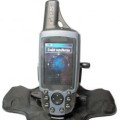Sneakers Are The Latest Home For Global Positioning Technology
In 1978, the U.S. Defense Department launched a satellite that, of course, had a long, military-sounding name. Similar launches followed, as the nation set up what is now commonly known as the Global Positioning System, or GPS. It has had some predictable uses and unexpected ones as well.
The military uses GPS satellites -- which triangulate signals bounced from a spot on earth -- to pinpoint installations and potential targets no bigger than a truck. Using GPS, geographers in the field are now able to note precise coordinates of, say, the exact mid-point of South Dakota, so that others can go to that very place. Companies put GPS technology into boats and automobiles as a navigation tool. Police can quickly find stolen cars carrying hidden GPS devices.
As for those unexpected uses: Authorities are equipping uspects, probationers, and kids who chronically skip school with GPS bracelets so their movements can be tracked. Private investigators, hired by a suspicious spouse, use GPS to follow the husband or wife. Pet owners have GPS chips implanted into their straying dogs and cats. The lives of stranded hikers and climbers wearing GPS transmitters have been saved. Global positioning technology helps the visually impaired to get around. Parents are buying their children GPS-equipped cell phones.
And one of the most imaginative examples of GPS technology will debut this summer. It's a sneaker, or athletic shoe, with a built-in GPS device. The wearer can switch it on, or a law-enforcement agent can do so if the person goes missing.
These GPS sneakers will be expensive -- in the $300 range. And they will require batteries plus payment of a monthly fee to the company that's tracing the signals. And of course, there's nothing to prevent the kid or old person who's being monitored from simply taking the shoes off!

